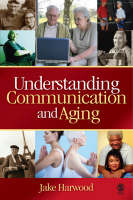
Understanding Communication and Aging
SAGE Publications Inc (Verlag)
978-1-4129-2609-6 (ISBN)
- Keine Verlagsinformationen verfügbar
- Artikel merken
"This interesting, easy-to-read book provides a comprehensive framework for considering communication and aging in the context of biology, sociology, and psychology. This thought provoking book is strongly anti-ageist. It could serve as a broad overview for anyone interested in the myriad of issues related to communication and aging." —CHOICE
"Understanding Communication and Aging achieves a nice balance between the facts of growing old, the social forces that shape that process, and the communication factors that connect these two domains. With attention to both research and everyday applications, the text is thorough and inviting. I am delighted that a user-friendly, undergraduate text has finally been produced in the field of communication and aging. This book deserves to be an instant and sustained success."
—Sandra Metts, Illinois State University
"This book has so many strengths. I am especially pleased with the communication focus and the discussions on cultural issues, new technologies, and identities. I am impressed by Dr. Harwood′s creativity and reaching out to learners via the use of info boxes, significant achievement profiles, literary/artistic descriptions, selected detailed summaries of research, and quotations about aging. All of these features auger very well for student learning and enthusiasm. I commend Dr. Harwood for his attention to detail, targeting multiple learning styles, and attending to instructors who value these kinds of features."
—Jim L. Query, Jr., University of Houston
"The way Professor Harwood ties together theory, research, and everyday experience into a text that is accessible, interesting, and fun to read is impressive. The focus is not merely psychological or interpersonal; the book spans multiple disciplines. This text is the total package!"
—Jo Anna Grant, California State University, San Bernardino
Understanding Communication and Aging is the most accessible introduction to the many ways aging in the 21st century is influenced by human communication processes, from face-to-face conversation to mass media representations. With a lively presentation, author Jake Harwood presents central research findings while engaging students with important questions concerning communication and aging.
Key Features
Covers the broad area of communication and older adulthood: The book examines key topics such as interpersonal and family relationships in old age, media portrayals of aging, cultural variations in intergenerational communication, and health communication in old age.
Shatters the myths and stereotypes of aging: The book′s orientation and perspective is on "healthy" living and aging. This anti-ageist approach encourages readers to reexamine their views on aging and become fluent at defending and promoting an anti-ageist ideology.
Provides concrete examples: While taking a theoretical approach, the book includes coverage of applied issues such as health communication and age-related prejudice and discrimination.
Jake Harwood (Ph.D., Communication, University of California, Santa Barbara) is Professor of Communication at the University of Arizona. He is author of Understanding Communication and Aging (2007, Sage) and co-editor of The Dynamics of Intergroup Communication (Peter Lang, 2011). His publications have appeared in Personality and Social Psychology Bulletin, Journal of Applied Communication Research, Communication Monographs, Human Communication Research, and the British Journal of Social Psychology, among others. His research focuses on intergroup communication with a particular focus on age groups. He is interested in the ways in which cognitive (e.g., stereotypes) and societal (e.g., mass media) representations of groups relate to communication processes.
Part I. Introduction to the Study of Aging and Intergenerational Communication
1. Perspectives on Aging
Why Study Aging?
Approaches to Aging
Methods for Studying Aging
Summary
Keywords and Theories
Discussion Questions
Annotated Bibliography
2. A Communication Approach to Aging
Decline in Communication
Counterpoint: A Positive Research Agenda on Aging
Approaches to Communication and Aging
Key Propositions Guiding the Book: A Communication Approach
Summary
Keywords and Theories
Discussion Questions
Annotated Bibliography
Part II. Attitudes About Aging and Interpersonal Communication
3. Stereotypes and Attitudes About Aging and Intergenerational Communication
Distinguishing Stereotypes and Attitudes
Attitudes Concerning Aging
Stereotypes of Aging
Age Identity-Talkin′ ′Bout My Generation
Cognitive Representations of Intergenerational Communication
Why Do Negative Attitudes and Stereotypes Matter?
Summary
Keywords and Theories
Discussion Questions
Annotated Bibliography
4. Aging, Identity, Attitudes, and Intergenerational Communication
Communication Accommodation Theory
The Communication Predicament of Aging (CPA) Model
The Age Stereotypes in Interaction Model
Supporting Dependency
Other Dimensions of Accommodation
Age Identity: Disclosing and Concealing Age in Communication
Summary
Keywords and Theories
Discussion Questions
Annotated Bibliography
5. Intragenerational Relationships in Older Adulthood
Marital Relationships in Old Age
Intragenerational Friendships in Old Age
Sibling Relationships
Summary
Keywords and Theories
Discussion Questions
Annotated Bibliography
6. Intergenerational Relationships in Older Adulthood
Grandparenting
The Parent-Child Relationship in Older Adulthood
Intergenerational Friendships
Summary
Keywords and Theories
Discussion Questions
Annotated Bibliography
7. Enhancing Communication with Older Adults
Change in Young People: The Influence of Intergenerational Contact on Attitudes
Ending the Predicament: The Communication Enhancement Model
Change in Older Adults: Confronting Patronizing Talk
Communication Skills and Communication Training
Summary
Keywords and Theories
Discussion Questions
Annotated Bibliography
Part III. Social Representations and Mass Communication
8. Mass Communication Portrayals of Older Adults
Underrepresentation
Negative Representation
Positive Portrayals
The Media Industry
Summary
Keywords and Theories
Discussion Questions
Annotated Bibliography
9. Uses and Effects of Media
Age Differences in Media Use
Uses and Gratifications Theory
Media Effects
Older People as "Embracers" of Television?
Summary
Keywords and Theories
Discussion Questions
Annotated Bibliography
10. Culture, Communication, and Aging
East Asia
South Asia (India)
United States Latino Cultures
Native American Cultures
Globalization and Transcultural Themes
Summary
Keywords and Theories
Discussion Questions
Annotated Bibliography
Part IV. Contexts of Communication in Older Adulthood
11. Health and Health Care
Physician-Older Patient Interaction
Support Groups for Caregivers
Elder Abuse
Additional Topics
Summary
Keywords and Theories
Discussion Questions
Annotated Bibliography
12. Technology
Stereotypes of Older Adults-Technological Competence
The Reality of Older Adults-Computer Use
What Do Older People Do on the Internet?
Technology and the Workplace
Summary
Keywords and Theories
Discussion Questions
Annotated Bibliography
Part V. Conclusion
13. Conclusion
A Model of Aging in Individual and Societal Context
What Can You Do Now?
Summary
Keywords and Theories
Discussion Questions
Annotated Bibliography
| Erscheint lt. Verlag | 10.7.2007 |
|---|---|
| Verlagsort | Thousand Oaks |
| Sprache | englisch |
| Maße | 152 x 228 mm |
| Gewicht | 450 g |
| Themenwelt | Sachbuch/Ratgeber ► Gesundheit / Leben / Psychologie ► Familie / Erziehung |
| Studium ► 1. Studienabschnitt (Vorklinik) ► Histologie / Embryologie | |
| Sozialwissenschaften ► Kommunikation / Medien ► Kommunikationswissenschaft | |
| Sozialwissenschaften ► Soziologie | |
| ISBN-10 | 1-4129-2609-2 / 1412926092 |
| ISBN-13 | 978-1-4129-2609-6 / 9781412926096 |
| Zustand | Neuware |
| Haben Sie eine Frage zum Produkt? |
aus dem Bereich


